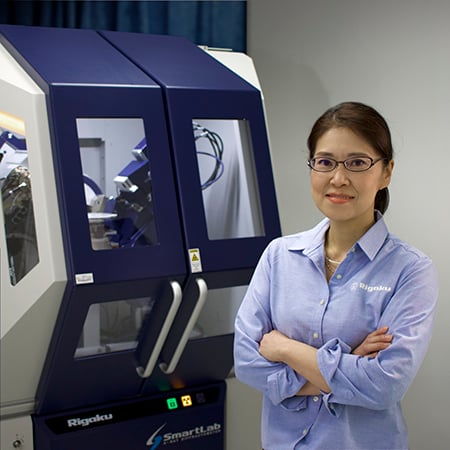Beneath the Surface: X-ray Analyses of Battery Materials and Structures
2. How to Run in Operando XRD Experiments

This is a written summary of a live webinar presented on November 15, 2023. The recording and resources are available on the recording page.
Presented by:
Webinar summary
The webinar, part of a series focused on X-ray analysis of battery materials, provided a comprehensive exploration of operando X-ray diffraction (XRD) techniques and their application to battery research. The session aimed to educate attendees on how operando XRD can be used to monitor structural changes in battery materials during actual operation—charging and discharging—thereby offering insights into performance, degradation, and phase transitions in real time.
Operando XRD allows researchers to observe how the crystal structure of battery components evolves dynamically. Two primary XRD geometries—reflection and transmission—were discussed in detail. Reflection geometry is more surface-sensitive and typically uses softer X-rays such as copper or cobalt radiation. In contrast, transmission geometry enables full-depth penetration using harder X-rays like molybdenum or silver, making it suitable for studying the entire internal structure of pouch cells or solid-state configurations. Case emphasized how these geometries can be selected based on the battery type and specific information sought.
A crucial enabler of operando XRD experiments is the use of dedicated sample stages. The presentation covered multiple configurations for liquid-based lithium-ion batteries, solid-state batteries, pouch cells, and coin cells, each with distinct sample holder designs and X-ray window materials such as aluminum or Kapton. The need for airtight assembly, usually performed in a glovebox, was emphasized, especially for sensitive solid-state batteries that require controlled pressurization. Various stage types—including temperature-controlled pouch cells and XY mapping holders—enable spatial and thermal studies, adding flexibility for complex experimental needs.
The speakers also guided the audience through the process of sample preparation and instrument setup using video demonstrations. These covered the full procedure from assembling the battery cell—layering cathode, separator, anode, spacers, and window materials—to mounting the sample holder on the diffractometer and integrating it with the potentiostat for electrical control. Synchronization between the potentiostat and the XRD system was shown to be straightforward, enabling simultaneous recording of structural and electrochemical data. Software tools allow real-time visualization of XRD patterns alongside voltage/current profiles, with functionality to animate these changes over time for deeper analysis.
Several detailed case studies illustrated the capabilities of operando XRD in battery research. One example involved involved lithium cobalt oxide (the sample is NMC like the example below) and showed how the 003 XRD peak shifts with varying lithium concentration, correlating structural expansion and contraction with charge states. Another example demonstrated how phase changes in NMC (nickel-manganese-cobalt) cathodes and graphite anodes follow distinct stage transformations—such as the well-known staging behavior in graphite, defined by different lithium intercalation levels. These transitions were visibly tracked through changes in peak position and intensity, offering direct evidence of phase reversibility and electrochemical hysteresis.
A segment was dedicated to C-rate dependency, showing how faster charging (e.g., 5C vs. 1C) can prevent complete phase transitions due to kinetic limitations. Quick scans made possible by 2D detectors covering large diffraction angles in a single exposure were essential for such studies. High-speed acquisition enabled monitoring of peak evolution in as little as 10 seconds, revealing incomplete lithium extraction at high C-rates—a finding critical to understanding fast-charging limitations.
The session also included a study on solid-state sodium batteries using titanium disulfide cathodes and sodium-based electrolytes. Operando XRD data revealed phase transitions and incomplete reaction zones within the cathode. This case highlighted the utility of the technique for non-lithium systems and solid electrolytes. Another example addressed temperature-dependent behavior in lithium manganese oxide polymer batteries. Operando XRD data at 50°C, room temperature, and 0°C showed that battery capacity declined significantly with lower temperatures, while lattice parameter shifts also became more muted—suggesting reduced lithium mobility and structural flexibility at colder conditions.
Throughout the webinar, questions from attendees helped clarify use cases, such as whether amorphous materials benefit from operando XRD. The guidance was nuanced: if amorphous materials are expected to crystallize during operation, operando XRD is worthwhile; otherwise, pair distribution function (PDF) analysis—a topic for a future webinar—would be more appropriate.
In summary, the webinar addressed how operando XRD techniques can be applied to study both liquid and solid-state batteries, under varying temperatures and charging rates. It provided practical setup guidance, demonstrated real-world applications, and highlighted how structural insights gained through XRD complement electrochemical performance data. This integration is essential for designing more efficient, durable, and safe battery systems—making operando XRD an indispensable tool in battery research.
Key questions answered in the webinar
-
Operando X-ray diffraction (XRD) is a powerful analytical technique that allows researchers to study the real-time structural changes occurring within a battery during its operation (charging and discharging cycles). By synchronizing XRD measurements with electrochemical data (like potential and current from a potentiostat), operando XRD provides insights into:
- Crystal and semi-crystal structures: This includes changes in the size of the crystal particles and grain size.
- Lattice parameters (Lattice constants): Operando XRD is highly sensitive to changes in the interatomic distances within the crystal lattice. As lithium ions intercalate (move into) or deintercalate (move out of) a material, the crystal structure can expand or shrink, leading to shifts in XRD peak positions.
- Phase transitions: It can identify when and how different crystalline phases form or disappear during charging and discharging, revealing the specific stages of lithium intercalation (e.g., in carbon anodes or cathode materials like lithium cobalt oxide).
- Reaction reversibility: By observing whether structural changes are symmetrical and return to their original state during both charging and discharging, operando XRD can assess the reversibility of electrochemical reactions.
- Unreacted material: The technique can detect if certain components of the battery, like cathode material, remain unreacted even after cycling, indicating inefficiencies.
Essentially, operando XRD helps understand the fundamental relationship between a battery's electrical properties and its internal structural evolution, offering crucial information for optimizing battery design and performance.
-
Operando XRD utilizes two primary geometries, each with specific X-ray source requirements:
- Reflection geometry: In this setup, the X-ray beam hits one surface of the battery cell (e.g., a pouch cell), and the diffracted X-rays are recorded from the same side. This geometry is more sensitive to the surface side of the pouch due to limited X-ray penetration. It can use softer X-ray radiations like copper (Cu), cobalt (Co), molybdenum (Mo), or silver (Ag).
- Transmission geometry: This geometry requires harder (shorter wavelength or higher energy) X-rays, such as molybdenum (Mo) or silver (Ag) sources. Here, the X-rays pass through (transmit) the entire battery sample. This allows for the analysis of all materials within the pouch, including cathode, anode, and electrolyte, providing a bulk structural overview.
The choice of geometry and X-ray source depends on the specific material being analyzed, its thickness, and the desired depth of penetration and spatial resolution. For instance, thicker samples or those requiring analysis of internal layers often benefit from harder X-rays and transmission geometry.
-
Dedicated sample stages are crucial for conducting operando XRD experiments. These stages are designed to hold various battery formats while allowing for X-ray exposure and connection to electrochemical measurement equipment. Common types include:
- Battery cells (Electrochemical cells): These are often stainless steel chambers designed for liquid-based lithium-ion batteries. They feature a small, thin X-ray window (typically aluminum, less than 20 μm thick for soft X-rays) to allow X-ray transmission. They are airtight for glovebox preparation and operate at ambient temperature.
- Solid state battery cells: Similar to liquid battery cells but designed to accommodate and pressurize pellet-shaped solid-state battery structures. Pressurization (up to 1 kilonewton or 12 megapascals for a 10 mm pellet) ensures good physical contact between solid components. They are also airtight and prepared in a glovebox.
- Coin cell holders: These allow for operando XRD measurements on standard coin cells. For transmission geometry, coin cells must have two X-ray transparent windows (e.g., Kapton foil) on both surfaces, as the stainless steel coin cell case itself is too thick and absorbing for X-rays.
- Pouch cell holders: Available in various configurations for transmission geometry, typically using molybdenum or silver X-ray sources:
- Single point pouch cell: Measures only the center part of the pouch.
- XY mapping combined pouch cell: Allows for spatial mapping by moving the pouch cell in X and Y directions, revealing structural distribution across the battery.
- Temperature controlled pouch cell: Enables operando measurements within a controlled temperature range (e.g., -10°C to +110°C) to study temperature dependence of structural changes.
Each stage is designed to provide optimal conditions for specific battery types and experimental needs, ensuring proper sample mounting, X-ray access, and environmental control.
-
The synchronization between the potentiostat (which controls the electrochemical cycling, e.g., charging and discharging) and the XRD instrument is critical for operando measurements. This is typically achieved through integrated software solutions:
- Potentiostat and XRD software integration: The XRD instrument's control software is designed to communicate with the potentiostat's software (e.g., Biologic potentiostats).
- Trigger signals: The potentiostat's software initiates the electrochemical cycle (e.g., a charge step) and sends a trigger signal to the XRD software.
- Synchronized data acquisition: Upon receiving the trigger, the XRD software starts an X-ray scan. This allows for the collection of XRD patterns at specific points or continuously throughout the charging/discharging process.
- Repeat cycling and fast acquisition: For dynamic processes, especially those involving fast C-rates, rapid XRD data acquisition is essential. This can be achieved by using large 2D detectors that cover a wide range of diffraction angles simultaneously, eliminating the need for traditional goniometer scanning.
- Data visualization and analysis: Post-measurement, specialized data analysis software can display both the electrochemical profile (potential vs. time) and the corresponding XRD data on the same interface. This allows researchers to track structural changes (like peak shifts or intensity changes) in direct correlation with the battery's electrical behavior, and even create dynamic "movies" of the structural evolution.
-
Operando XRD effectively reveals lithium intercalation and resulting phase transitions by monitoring changes in the diffraction patterns. As lithium ions move into or out of a material's crystal structure during charging and discharging:
- Peak shifts: The lattice parameters (the dimensions of the unit cell) of the crystal change, causing the diffraction peaks to shift to different 2θ angles. For example, in lithium cobalt oxide (LCO), specific peaks (like the 003 peak) show a clear shift depending on the lithium concentration. An elongated lattice due to lithium intercalation might cause peaks to shift to lower angles, while shrinkage due to deintercalation would cause shifts to higher angles.
- Appearance/disappearance of peaks: New crystalline phases may form, leading to the appearance of new diffraction peaks. Conversely, existing phases may disappear, causing their corresponding peaks to vanish or significantly diminish.
- Changes in peak intensity: The relative intensity of diffraction peaks can indicate the proportion of different phases present. As one phase transforms into another, the intensity of its characteristic peaks will decrease, while the intensity of peaks from the new phase will increase. For example, in lithium iron phosphate (LFP), the intensities of peaks corresponding to LiFePO₄ and FePO₄ exchange as lithium ions are extracted or inserted.
By tracking these changes in real-time, operando XRD allows researchers to identify intermediate phases, understand the reversibility of phase transformations, and determine the exact state of lithium intercalation within the active materials, offering critical insights into the battery's electrochemical mechanism.
-
C-rate (charge/discharge rate) dependence is a critical aspect of battery performance, and operando XRD is an excellent tool to investigate how varying charge/discharge speeds affect the structural changes within battery materials. To effectively study C-rate dependence, very fast XRD data acquisition is required, especially for high C-rates (e.g., 5C, where a full charge/discharge takes only 12 minutes).
- Rapid Data Collection: This is achieved using high-energy X-ray sources (like molybdenum or silver) combined with large 2D detectors that can capture a wide range of diffraction angles simultaneously (e.g., 15° 2θ coverage) without the need for traditional goniometer scanning. This allows for exposure times as short as 10 seconds per scan.
- Monitoring Phase Evolution at Speed: By collecting rapid XRD patterns during high-speed cycling, researchers can observe how the transformation between different crystalline phases (e.g., lithium iron phosphate and iron phosphate) occurs under accelerated conditions.
- Assessing lithium extraction/insertion efficiency: Operando XRD can show if all lithium ions are completely extracted or inserted at higher C-rates. For example, in LFP, at 1C and 3C, the intensities of the two phases (LiFePO₄ and FePO₄) completely exchange, indicating full lithium extraction. However, at 5C, some intensity from the unreacted phases might remain, suggesting that not all lithium ions are extracted or inserted, which explains why the battery's capacity might be lower at higher C-rates.
This capability helps in understanding the limitations of battery materials at different operational speeds and guiding the development of faster-charging batteries.
-
Solid-state batteries are a hot topic in research due to their potential for enhanced safety and energy density. Operando XRD is crucial for understanding their unique behavior, particularly because they often involve solid electrolytes and require external pressure to ensure good contact between components.
- Pressure Application: Dedicated solid-state battery sample cells allow for the application of significant pressure (e.g., 1 kilonewton) to the pellet-shaped battery structure. This is vital to maintain physical contact between the solid cathode, solid electrolyte, and anode, which can influence ionic conductivity and reaction kinetics.
- Monitoring phase changes: Operando XRD tracks the structural changes within the solid components during charging and discharging. For example, in a sodium-based solid-state battery with titanium disulfide (TiS₂) cathode, the initial strong TiS₂ peak diminishes, and a new peak corresponding to sodium titanium disulfide (Na0.55TiS₂) appears and shifts, indicating sodium ion intercalation.
- Detecting unreacted material: The technique can identify if any of the solid active materials remain unreacted throughout the cycling process. If characteristic peaks of the original material persist, it suggests incomplete utilization of the active material.
- Optimizing design: By correlating structural evolution with electrochemical performance under specific pressure conditions, operando XRD provides insights into the effectiveness of material interfaces and phase transformations in solid-state batteries, guiding the optimization of their design and operating parameters.
-
Yes, operando XRD can be effectively used to study the temperature dependence of battery performance. This involves integrating temperature control mechanisms into the sample stages.
- Temperature control: Specialized pouch cell holders, for instance, can control the temperature from below freezing (e.g., 0°C) up to elevated temperatures (e.g., 110°C). This allows researchers to cycle the battery while simultaneously monitoring its crystal structure at different temperatures.
- Correlation with capacity: By performing operando XRD at various temperatures, it's possible to correlate the observed structural changes with the battery's electrochemical capacity. For example, a lithium manganese oxide (LMO) polymer battery shows a decrease in capacity as the temperature drops.
- Lattice parameter changes: Operando XRD can quantify how the extent of lattice parameter change (expansion/shrinkage) varies with temperature. Smaller changes in lattice parameters at lower temperatures, for instance, suggest reduced lithium ion movement, which explains the observed decrease in battery capacity. This provides direct evidence of how temperature affects the intercalation/deintercalation kinetics and the overall structural integrity of the battery materials.
Studying temperature dependence with operando XRD is crucial for understanding battery performance in diverse environmental conditions and for developing batteries that operate efficiently across a wide temperature range.

Subscribe to the Bridge newsletter
Stay up to date with materials analysis news and upcoming conferences, webinars and podcasts, as well as learning new analytical techniques and applications.

Contact Us
Whether you're interested in getting a quote, want a demo, need technical support, or simply have a question, we're here to help.


.jpg?width=300&height=300&name=Tim%20Bradow%20(1).jpg)